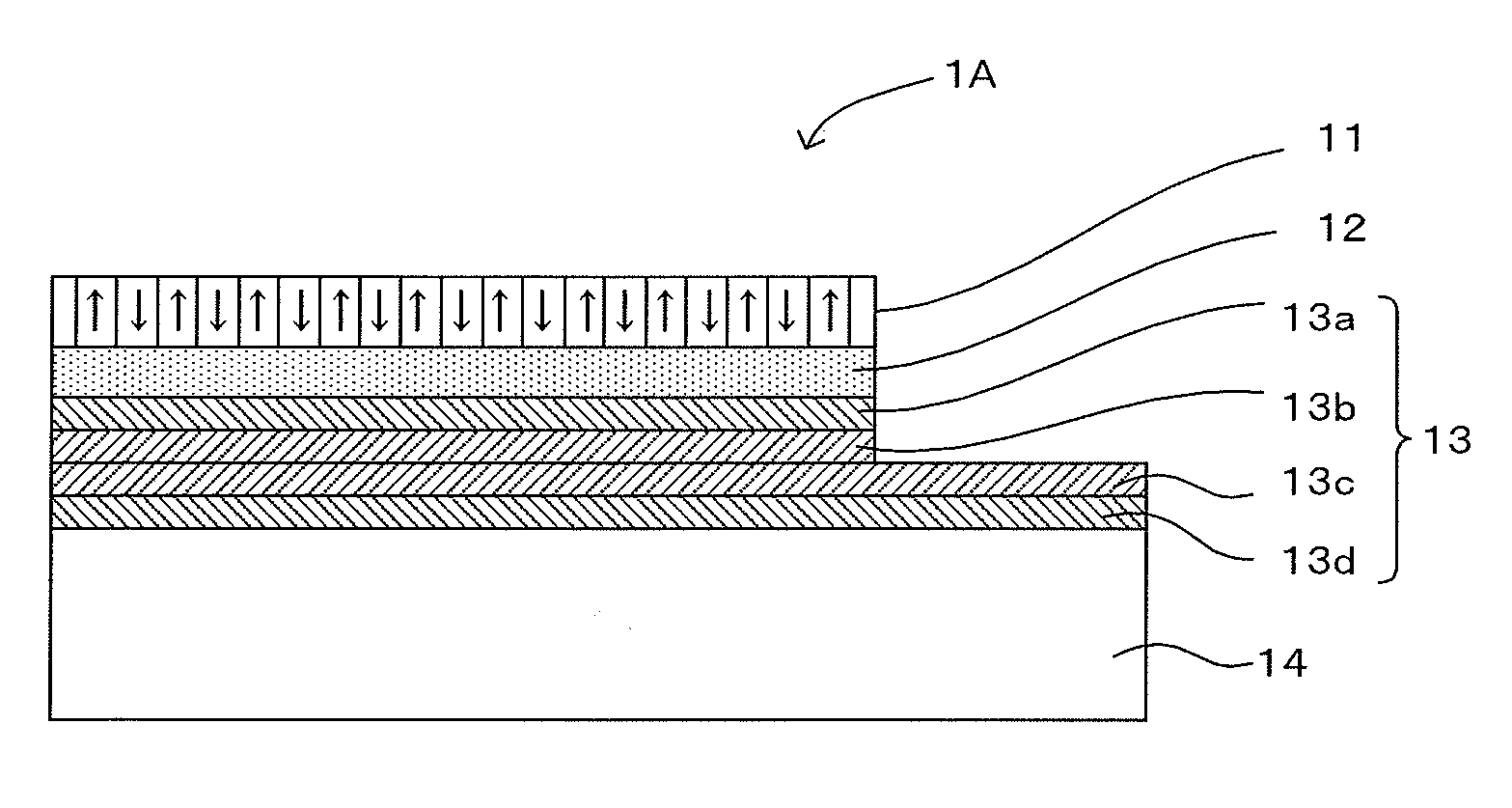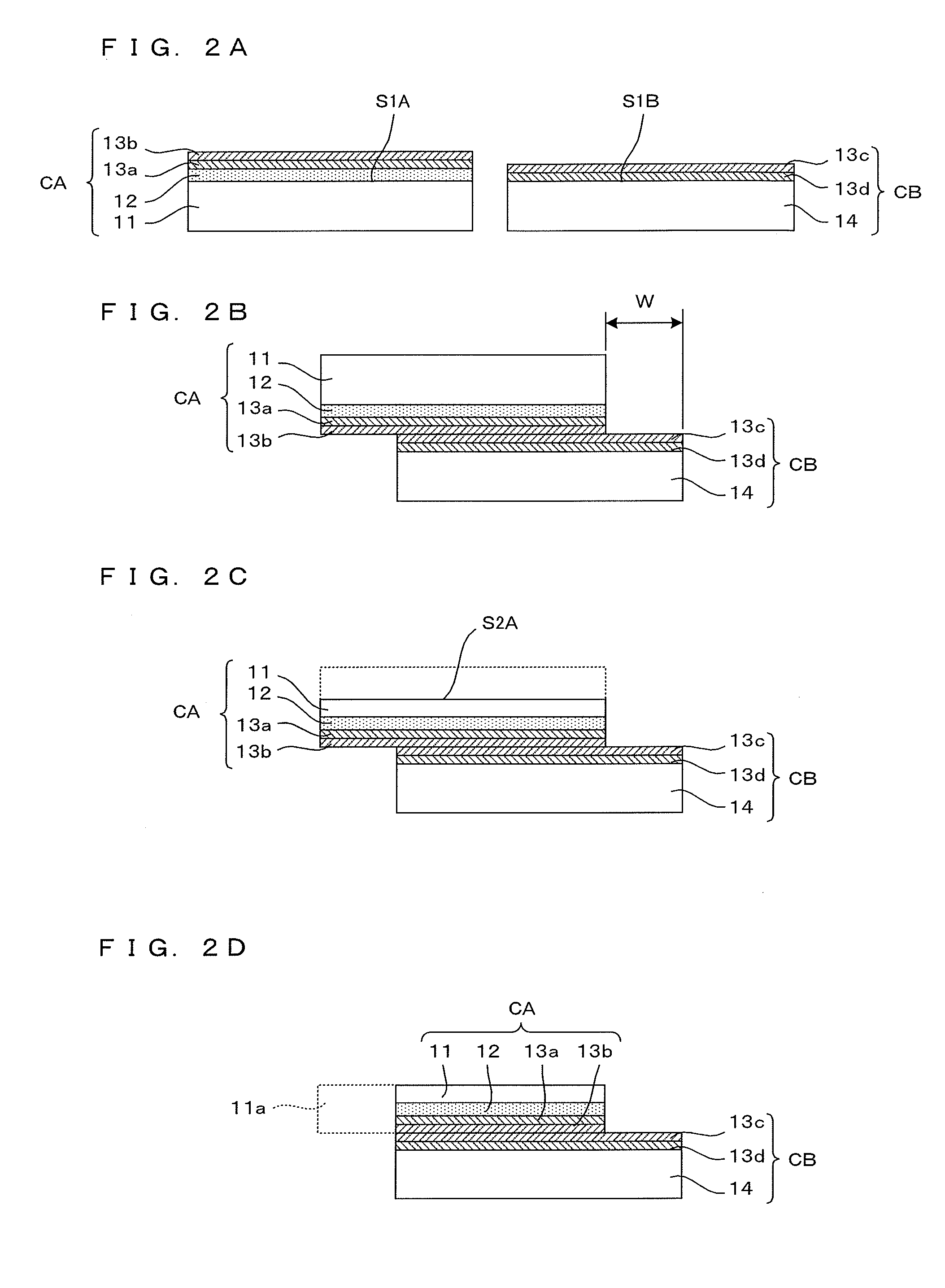Optical device, a method of manufacturing optical device, and exposure apparatus
a manufacturing method and optical technology, applied in the field of optical devices, can solve the problems of difficult to maintain uniform accuracy over a wide surface area, difficult for this optical modulator to perform modulation at a high speed, etc., to achieve the effect of reducing the driving voltage, reducing the thickness of ferroelectric crystals, and reducing the thickness of optical components
- Summary
- Abstract
- Description
- Claims
- Application Information
AI Technical Summary
Benefits of technology
Problems solved by technology
Method used
Image
Examples
first embodiment
[0033]FIG. 1 is a cross sectional view which shows a first embodiment of an optical device according the invention. The optical device 1A comprises a ferroelectric substrate 11 formed by periodically domain inverted (periodically poled) ferroelectric crystals, and a support plate 14 supports the ferroelectric substrate 11 via an insulation layer 12 of SiO2 or the like and a junction 13 which has a quadruple-layer structure. In this embodiment, processing described later is performed on a single crystal substrate of lithium niobate (MgO:lithium niobate) added with magnesium oxide (MgO) or stoichiometric lithium tantalite (MgO:stoichiometric lithium tantalite) added with magnesium oxide (MgO), whereby the periodically domain inverted ferroelectric substrate 11 is formed as a thin film. Lithium niobate added with magnesium oxide (MgO) will be hereinafter referred to as “MgO:LN” and stoichiometric lithium tantalite added with magnesium oxide will be hereinafter referred to as “MgO:SLT.”...
second embodiment
[0056]FIGS. 5A and 5B are cross sectional views which show a second embodiment of the optical device according to the invention. FIG. 5A shows the overall structure, and FIG. 5B is an enlarged schematic diagram of the section enclosed by the dotted line in FIG. 5A. FIGS. 6A through 6C are schematic diagrams of the manufacturing method of the optical device shown in FIGS. 5A and 5B, but show only characteristic steps of the manufacturing method according to the second embodiment. A major difference of the second embodiment from the first embodiment is the structure of the junction 13, and the other structures remain the same as those according to the first embodiment. Therefore, redundant descriptions will be omitted on the same structures which will instead be denoted at the same reference symbols.
[0057]In the second embodiment, the chromium film 13a and the gold film 13b forming the first metal layer are patterned in the arrangement pattern of the concave sections 15a formed in the...
third embodiment
[0066]FIGS. 7A through 7D are cross sectional views which show a third embodiment of the optical device according the invention. The optical device 1C according to the third embodiment is integration of the ferroelectric substrate 11 formed by ferroelectric crystals having periodically poled structure and the support plate 14, which is thicker than the ferroelectric substrate 11, via the quadruple-layer junction 13 as shown in FIG. 7D, and is manufactured in the following manner.
[0067]The third embodiment requires preparing the ferroelectric substrate 11 formed by ferroelectric crystals having periodically poled structure and the support plate 14. As in the first and the second embodiments, the support plate 14 has the same composition as that of the ferroelectric substrate 11 and is formed by ferroelectric crystals having the same absolute value of the crystal orientation as that of the ferroelectric substrate 11 according to the third embodiment. Through sputtering or deposition, ...
PUM
 Login to View More
Login to View More Abstract
Description
Claims
Application Information
 Login to View More
Login to View More - R&D
- Intellectual Property
- Life Sciences
- Materials
- Tech Scout
- Unparalleled Data Quality
- Higher Quality Content
- 60% Fewer Hallucinations
Browse by: Latest US Patents, China's latest patents, Technical Efficacy Thesaurus, Application Domain, Technology Topic, Popular Technical Reports.
© 2025 PatSnap. All rights reserved.Legal|Privacy policy|Modern Slavery Act Transparency Statement|Sitemap|About US| Contact US: help@patsnap.com



